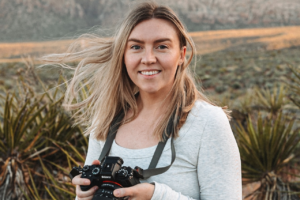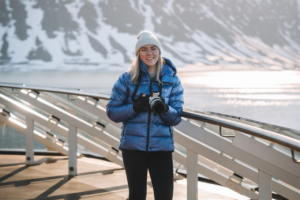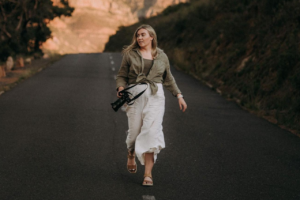Allison Anderson stands as a testament to creative innovation in the travel content space. Her journey from a general YouTube creator in 2009 to a respected voice in travel media by 2017 exemplifies the kind of strategic pivot that defines successful content creators in today’s digital landscape. Like a seasoned travel guide who knows the hidden pathways through a bustling city, Anderson has mapped out an alternative route to travel content success that challenges conventional wisdom.
The transformation of travel content creation over the past decade mirrors Anderson’s own evolution. Gone are the days when aspiring travel creators needed to choose between their steady careers and their dreams of sharing global experiences. The digital revolution has democratized content creation, yet paradoxically, the barriers to entry in the travel niche have remained stubbornly high. The traditional model—jetting off to exotic locations, capturing pristine footage of sundrenched beaches and hidden cafés—while aspirational, has become increasingly unsustainable for newcomers.
Anderson’s approach represents a refreshing departure from this paradigm. Rather than viewing limited travel opportunities as an insurmountable obstacle, she advocates for a more nuanced understanding of what constitutes valuable travel content. This perspective shift is particularly relevant in a world where authenticity often resonates more strongly than polished perfection. “Different niches have their own challenges,” she notes, acknowledging the unique hurdles of the travel sphere while simultaneously suggesting that these challenges can spark creative solutions.
The real genius of Anderson’s methodology lies in its accessibility. By breaking down the seemingly insurmountable wall between aspiration and execution, she has created a blueprint for content creation that doesn’t require a trust fund or unlimited vacation days. Her framework acknowledges the real-world constraints that most aspiring creators face: full-time jobs, limited budgets, and geographical restrictions. Yet rather than viewing these as limitations, she reframes them as opportunities for differentiation in a crowded digital landscape.
This approach resonates particularly well in an age where content consumption patterns are rapidly evolving. With the rise of short-form video content and the increasing appetite for authentic, relatable stories, the definition of what constitutes “travel content” has expanded considerably. Anderson’s journey suggests that success in this space isn’t necessarily about having the most stamps in your passport, but rather about understanding how to craft compelling narratives that speak to the universal human desire for exploration and discovery.
For aspiring creators, Anderson’s story offers more than just inspiration—it provides a practical roadmap for building a sustainable content creation business without sacrificing financial stability or personal commitments. Her experience demonstrates that the path to becoming a successful travel content creator is less about immediate global adventures and more about strategic thinking, creative resource utilization, and authentic storytelling.
In the glossy world of travel content creation, reality often collides with aspiration like waves against a rocky shore. While social media feeds overflow with sun-drenched vistas and perfectly composed café shots, the path to creating such content is far more complex than a simple point-and-shoot affair. Allison Anderson’s candid insights into this world reveal the intricate dance between passion and practicality that defines successful travel content creation.
Consider the financial architecture of traditional travel content: a weekend trip to capture content in Japan isn’t just about booking a flight. It’s an orchestrated investment involving accommodation, transportation, equipment, and the countless invisible costs that accumulate like grains of sand in an hourglass. A creator might spend thousands of dollars setting up a single shoot, with no guarantee of monetary return. This investment-heavy model creates what Anderson aptly describes as a “chicken and egg situation” – a paradox familiar to many aspiring creators who find themselves caught between the need to create high-quality content and the financial means to do so.
The temporal demands of travel content creation present an equally formidable challenge. Unlike lifestyle vloggers who can film from their living rooms or tech reviewers who can work from a home office, travel content creators face a unique scheduling conundrum. The traditional Monday-to-Friday work schedule becomes a gilded cage, restricting creators to weekend explorations that barely scratch the surface of what meaningful travel content demands. As Anderson notes, you can’t simply “fly to Japan for the weekend to make a travel video” while maintaining a full-time job.
This time constraint ripples through every aspect of content creation. Each piece of content requires not just the travel time itself, but hours of research, planning, filming, editing, and promotion. The reality is that creating compelling travel content is a full-time job masquerading as a passion project. Many creators find themselves burning the candle at both ends – working their day jobs while editing footage late into the night, their dreams of travel content success competing with the practical needs of financial stability.
The monetization puzzle adds another layer of complexity. Building a sustainable platform requires consistent content output, yet consistent travel requires substantial financial resources. This creates a circular dependency that can feel impossible to break. Successful creators often spend months or years building their platforms before seeing meaningful financial returns, investing both time and money with the patience of a gardener waiting for seeds to sprout.

Yet within these challenges lies an opportunity for innovation. The most successful travel content creators aren’t necessarily those with the biggest budgets or the most exotic locations, but those who understand how to work within these constraints while maintaining their creative vision. They find ways to create compelling content that resonates with audiences while navigating the practical limitations of time, money, and energy.
This reality check isn’t meant to discourage aspiring creators but rather to arm them with the knowledge needed to approach the field strategically. Understanding these challenges allows creators to develop sustainable strategies that align with their resources and limitations, rather than burning out trying to emulate an unsustainable ideal.
In the evolving landscape of digital media, the definition of travel content has undergone a remarkable transformation. While the genre once demanded a perpetually packed suitcase and a well-worn passport, innovative creators like Allison Anderson have pioneered approaches that prove compelling travel content can emerge from the most unexpected place: home.
The rise of short-form video has revolutionized how audiences consume travel content. In an age where TikTok and Instagram Reels dominate the attention economy, creators have discovered that the magic often lies not in the destination itself, but in the story being told. Anderson’s approach to leveraging stock footage exemplifies this shift, transforming what might seem like a limitation into a creative advantage. “Five beautiful beaches around the world,” she suggests, can become an engaging narrative without ever setting foot on the sand. The key lies in thorough research and storytelling finesse – letting viewers dream of Bora Bora’s crystal waters or the Seychelles’ pristine shores through carefully curated footage and informed commentary.
But perhaps the most intriguing aspect of home-based travel content creation is the emergence of what might be called “travel-adjacent” content. Consider the humble suitcase review – a piece of content that requires nothing more than a corner of your living room and a keen eye for detail. These practical pieces serve as the foundation of travel preparation, offering valuable insights to audiences while building creator credibility. The art of packing, once a mundane necessity, becomes a form of content that combines utility with entertainment, showing how even the most ordinary aspects of travel can be transformed into engaging narratives.
The technical aspects of production have also evolved to support this new paradigm. Professional-grade stock footage libraries have become the modern creator’s atlas, offering windows into worlds yet unexplored. As Anderson notes, a Storyblocks subscription often proves more valuable than a plane ticket, providing access to high-quality footage that can bring distant destinations into sharp focus. This democratization of visual resources has leveled the playing field, allowing creators to craft professional-quality content without the traditional barriers of travel expenses.
Travel bucket lists and personal travel mistakes have emerged as surprisingly rich veins of content. These topics tap into the universal experiences of travel – the anticipation, the mishaps, the lessons learned – without requiring current mobility. A creator sharing their most embarrassing travel faux pas or their dreams of future adventures creates connections through shared experiences and aspirations, proving that authentic travel content isn’t always about where you are, but rather the stories you tell and the wisdom you share.
The production value of home-based travel content has risen to meet audience expectations through creative problem-solving. Creators have transformed spare rooms into makeshift studios, mastered the art of narrative voiceover, and developed editing techniques that rival traditional travel shows. This evolution demonstrates that professional-quality travel content is more about skill and creativity than location – a revelation that has opened doors for countless aspiring creators.
This reimagining of travel content creation represents more than just a practical solution to logistical constraints; it’s a fundamental shift in how we think about travel storytelling. It suggests that the essence of travel content lies not in the distance covered, but in the perspectives shared and the connections forged with audiences seeking both inspiration and practical guidance for their own journeys.
In the pursuit of compelling travel content, creators often overlook the treasure trove of opportunities that lie just beyond their doorstep. As Allison Anderson astutely observes, “Local to you is far away to someone else” – a simple yet profound insight that reshapes how we think about travel content creation. This perspective transforms the familiar streets of one’s hometown from mundane backdrops into potential stages for storytelling.
Consider Kingston, Idaho, where Anderson uncovered a remarkable story in the form of a converted high school turned Airbnb. This discovery illustrates perfectly how extraordinary narratives often hide in plain sight, even in towns “this big.” The historic high school, with its classrooms transformed into sleeping quarters and its auditorium repurposed for modern guests, represents the kind of unique local content that captures audiences’ imagination. It’s not the grandeur of Paris or the beaches of Bali that makes this content compelling – it’s the unexpected nature of the discovery and the story it tells about American ingenuity and preservation.

The art of local content creation lies in developing what might be called “tourist vision” – the ability to see your surroundings through the eyes of a visitor. That retro diner you pass every day without a second glance might be someone else’s dream destination. The local coffee shop, with its carefully curated playlist and artisanal approach to roasting, could be the centerpiece of a story about your city’s evolving culinary scene. These everyday locations, when viewed through a fresh lens, become portals to stories waiting to be told.
Creating compelling local content requires a methodical approach to discovery and documentation. The best local creators become amateur anthropologists, studying their surroundings with renewed curiosity. They compile lists of rooftop bars with the best sunset views, scout locations for optimal photography angles, and build relationships with local business owners who can provide behind-the-scenes access and insights. This deep-dive into local culture often reveals layers of history and community that even longtime residents might have missed.
Anderson’s approach to local content creation extends beyond mere documentation to include practical considerations for content makers. By reaching out to property owners like the high school’s proprietor for permission to film, she demonstrates the importance of building relationships within your community. These connections often lead to exclusive access and unique storytelling opportunities that wouldn’t be available to traveling creators passing through.
The beauty of focusing on local content lies in its sustainability and depth. Unlike the challenges of international travel content, local stories can be developed over time, allowing creators to capture different seasons, events, and perspectives. A single location might yield multiple pieces of content: a historical deep-dive, a photographer’s guide to hidden spots, a food lover’s tour of local specialties, or a series about seasonal changes in the community.
For aspiring creators, this local-first approach offers a practical entry point into travel content creation. It eliminates the need for expensive travel while allowing them to develop their storytelling skills, build an audience, and establish their unique voice. More importantly, it helps creators understand that compelling content isn’t about distance traveled – it’s about the stories we tell and the perspectives we share.
The key to successful local content creation lies not in trying to compete with exotic destinations, but in embracing and celebrating the unique character of your area. Whether it’s a converted high school in Idaho or a hidden coffee shop in your neighborhood, every location has stories waiting to be discovered and shared with the world.
In the saturated landscape of travel content creation, authenticity has emerged as the ultimate currency. Allison Anderson’s insights reveal a profound truth about content creation: what might appear as limitations can become the very elements that set a creator apart. Through her own journey as a married solo traveler, Anderson demonstrates how personal circumstances can transform into powerful differentiators in the digital space.
Consider the seemingly paradoxical success of Anderson’s solo travel content. As a married creator who ventures out alone, she has tapped into a remarkably specific yet surprisingly vast audience: partnered individuals seeking independence through travel. This niche emerged not from market research or trend analysis, but from her authentic experience and circumstance. The majority of messages she receives come from women in relationships who are drawn to the empowering narrative of solo exploration within the context of partnership – a testament to the power of authentic positioning.
The evolution of travel content has created space for diverse voices and perspectives that were once overlooked. Teachers who can only travel during school holidays aren’t limited by their schedule; instead, they can become authoritative voices on maximizing vacation periods and navigating peak season travel. The constraints of their profession become the foundation of their expertise. Similarly, small-town residents embarking on their first international adventures can document their journey of discovery, creating content that resonates deeply with others who share their perspective of stepping into the unknown.
This approach to content creation challenges the traditional travel influencer model. Instead of trying to compete with seasoned globetrotters, creators can embrace their unique circumstances as a lens through which to view and share travel experiences. A parent navigating international destinations with toddlers isn’t just creating travel content – they’re providing invaluable insights for other families facing similar challenges. Their trials, triumphs, and learned wisdom become a roadmap for others walking the same path.
The key lies in understanding that authenticity in travel content isn’t about fitting into predetermined molds but about embracing and articulating your distinct perspective. Anderson’s experience shows that audiences are drawn to creators who reflect their own circumstances and aspirations. A traveling teacher using #thetravelingteacher isn’t just sharing destinations; they’re creating a community around shared experiences and constraints, offering solutions and inspiration to others balancing profession and wanderlust.
This approach to content creation extends beyond mere demographics to touch on deeper aspects of identity and experience. Whether it’s solo female travelers seeking safety tips, digital nomads balancing work and exploration, or budget travelers maximizing limited resources, each creator’s unique combination of circumstances can inform content that speaks directly to specific audience needs and desires.

The power of this personal approach lies in its ability to create genuine connections. When content emerges from lived experience rather than manufactured expertise, it carries an authenticity that audiences can sense and trust. For creators just starting their journey, this means that their current situation – whether it’s limited travel experience, geographic constraints, or specific life circumstances – isn’t a handicap but rather the foundation upon which they can build their unique voice in the travel content space.
As Anderson’s success demonstrates, the future of travel content isn’t about presenting a polished, universal narrative but about embracing and sharing individual perspectives that resonate with specific audiences. In doing so, creators don’t just build platforms – they cultivate communities united by shared experiences, challenges, and aspirations.
The landscape of travel content creation stands at a fascinating crossroads, where traditional notions of wanderlust intersect with modern digital storytelling. Through Allison Anderson’s lens, we discover that the future of travel content isn’t necessarily written in passport stamps or measured in miles traveled, but rather in the authentic connections and valuable insights shared with eager audiences.
This evolution in travel content creation mirrors broader shifts in digital media consumption. Just as the rise of social media democratized publishing, Anderson’s approach democratizes travel storytelling. Her framework dismantles the perceived barriers to entry that have long kept talented creators from sharing their unique perspectives on travel and exploration. The result is a more inclusive, diverse landscape of travel content that benefits both creators and consumers.
What emerges from Anderson’s insights is a new definition of success in travel content creation – one that values creativity and authenticity over quantity of destinations visited. This perspective shift is particularly poignant in an era where sustainability and mindful travel have become increasingly important. Rather than contributing to overtourism or encouraging unsustainable travel practices, this approach promotes thoughtful, purposeful content creation that can inspire and inform without requiring constant movement.
The beauty of this paradigm lies in its accessibility. Aspiring creators no longer need to choose between their dreams of content creation and their current life circumstances. Instead, they can begin their journey from wherever they are, using the tools and resources at their disposal to craft compelling narratives that resonate with specific audiences. This approach not only makes travel content creation more sustainable for creators but also more relatable for audiences who may share similar constraints or circumstances.
Perhaps most significantly, Anderson’s framework challenges us to reconsider what makes travel content valuable. In a world saturated with picture-perfect Instagram posts and carefully curated experiences, there’s a growing appetite for authentic stories and practical insights. Whether it’s exploring local hidden gems, sharing travel planning tips, or offering perspective on solo adventures, the value lies not in the exclusivity of the destination but in the uniqueness of the storytelling approach.
As we look to the future of travel content creation, it’s clear that success will increasingly belong to those who can craft meaningful narratives regardless of their geographic location or travel frequency. The path forward isn’t about competing with established travel influencers or replicating their journeys, but about finding and sharing your unique voice in the vast landscape of travel storytelling. Anderson’s approach reminds us that in content creation, as in travel itself, the journey is often more important than the destination.


